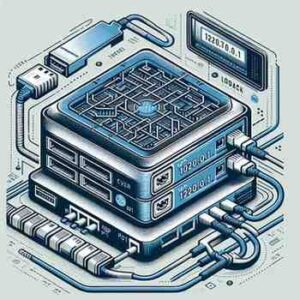Within the network world, particular addresses and port numbers play a major role. One such address is 127.0.0.1, commonly referred to by the name “localhost.” When paired with a port number like 62893, it serves a specific purpose for local network connections and server configurations. This article aims to dispel 127.0.0.1:62893, explaining its importance and providing insight into its frequent uses, problems, and troubleshooting tips.

Contents
- What is 127.0.0.1:62893?
- The significance of port numbers
- Understanding 62893
- The value of loopback addresses
- How does localhost work?
- How Operating Systems Work Role of Operating Systems
- Network Interface Cards (NICs)
- DNS, localhost, and DNS
- Common Usage of 127.0.0.1:62893
- Potential problems
- There are many misconceptions about 127.0.0.1
- Troubleshooting Tips
- Conclusion
What is 127.0.0.1:62893?
127.0.0.1 The IPv4 address belongs to localhost. This IPv4 address corresponds to the hostname of the device you are currently using. Simply It serves as a loopback address for your PC to exchange information with the device. For testing and development purposes, use this globally recognized address. It allows software developers to run apps locally and debug without having to connect to an external network.
The significance of port numbers
In a network, a port number helps locate specific processes or services on a machine. While an IP address (for example, 127.0.0.1) identifies the computer, port numbers identify the specific program or service it runs on. Port numbers range from 1 to 65535, with a variety of options for different types of services.
Understanding 62893
People often use the randomly assigned high port number 62893 for temporary and ephemeral purposes. The port number 62893 is not as well-known (like port 80, which allows HTTP, or ports 443 and HTTPS, for example). The operating system tends to dynamically assign port numbers with high values to facilitate quick-lived connections.
The value of loopback addresses
Loopback addresses, such as 127.0.0.1, can be crucial for several reasons. They allow developers to create applications locally without requiring an external network. They simplify and boost the efficiency of debugging processes. Utilizing loopback addresses, you are able to isolate your working environment and ensure that other factors aren’t affecting your testing.
How does localhost work?
Knowing a local host’s function could reveal valuable information about its capabilities. When you access 127.0.0.1, your computer will never receive a request. Instead, it loops back to the local machine, resulting in the name “loopback.” The operating system controls this procedure, directing traffic to the appropriate network interfaces.
How Operating Systems Work Role of Operating Systems
Operating systems like Windows, macOS, and Linux treat localhost requests differently. However, the core principle remains the same. The system intercepts requests to 127.0.0.1 and sends them directly to the machine in your local area. This will ensure that your device can communicate with itself in a timely manner.
Network Interface Cards (NICs)
Network Interface Cards (NICs) also play a key role in handling localhost data. Furthermore, NICs typically manage both external and internal connections to networks. This two-part function makes NICs versatile components in any computing environment.
DNS, localhost, and DNS
The Domain Name System (DNS) is a different key element in the localhost equation. DNS will translate human-readable domain names to IP addresses. If you hit “localhost” in your browser, the DNS will resolve it to 127.0.0.1. This seamless translation is what makes localhost so accessible and user-friendly.

Common Usage of 127.0.0.1:62893
- Local development and testing Developers usually use localhost addresses with different port numbers for running the web server, databases, and other functions locally. For example, you could run an application for the web on your personal computer using 127.0.0.1:62893 before deploying it into an actual environment.
- Network Troubleshooting System administrators use localhost and port numbers to identify the underlying causes of network issues. You can run the software locally to verify that devices are configured correctly for operation.
- Secure Communications Local host addresses play a crucial role in ensuring secure communications when necessary. For example, when creating secure apps, developers may use local addresses to simulate real-world scenarios without having to expose the application to external risks.
Potential problems
Although using 127.0.0.1:62893 is generally easy, some issues may arise:
- Port Conflicts In a situation where multiple applications attempt to connect using the same port number, a problem could occur. This can cause any of them to fail to start or operate properly.
- Secure and firewall Settings: Local firewalls or security software could block certain ports. This could include port numbers like 62893. These could stop programs from communicating as intended.
- Confusions Uncorrectly configured services or software can lead to issues where the software doesn’t connect to the right address or port.
There are many misconceptions about 127.0.0.1
However, despite its simplicity, people frequently unintentionally misunderstand 127.0.0.1. The following article will dispel the myths surrounding 127.0.0.1 and discuss its importance for networking.
This is not a network.
Many people believe that localhost is a network. Actually, it’s just a specific address for routing data within a local machine. The distinction between these two is vital for any person working with networking principles.
All loopback addresses have the same 127.0.0.1
While 127.0.0.1 is most often utilized as a as a loopback address, it’s in no way the only loopback address. The entire 127.0.0.0/8 block is reserved exclusively for loopback uses. But 127.0.0.1 remains the go-to solution due to its simplicity and widespread adoption.
Localhost is only for developers.
Another myth is that localhost is only useful to developers. While it’s true that most developers use 127.0.0.1, networking professionals or security experts—even the casual user—can benefit from understanding and utilizing localhost.
Troubleshooting Tips
- Check port availability. Use command-line tools such as netstat or lsof to determine if port 62893 is utilized. If it is, then you may require the correct port.
- Verify firewall settings. Be sure your firewall or security software allows for traffic via port 62893. It may be necessary to develop particular rules for traffic.
- Review of Configuration Files Verify your configuration files in your applications to verify they’re set correctly to use 127.0.0.1 in addition to the desired port number.
- Restart Services: Sometimes, simply restarting the affected system or services can resolve issues related to port bindings.
Conclusion
127.0.0.1:62893 is a mix of a loopback IP address as well as higher port numbers commonly utilized locally for development testing and troubleshooting. Knowing how you can effectively use and resolve issues with this combination could substantially improve your networking as well as your work processes in development. When you adhere to the most effective practices, as well as keeping an eye on any potential problems, you can guarantee the smooth and reliable local operation of your network.
127.0.0.1 might appear like an obvious concept, but its importance and application cannot be overemphasized. From the development of software to problem-solving, localhost’s a useful tool that facilitates and streamlines technical workflows.
For IT professionals, networkers, and local business owners at the same time, knowing and exploiting 127.0.0.1 can bring numerous advantages. When you incorporate best practices and maintain a current understanding of emerging trends, you can make the most of this invaluable resource.
Are you ready to unleash the full benefits of localhost? Explore today to see how 127.0.0.1 could revolutionize workflows and make you more proficient in technical matters.